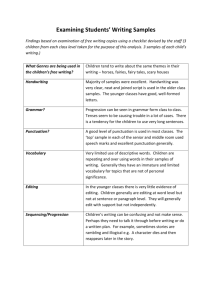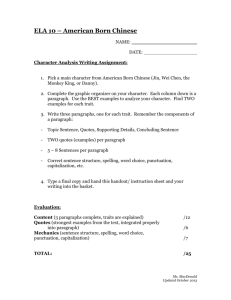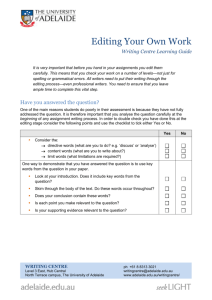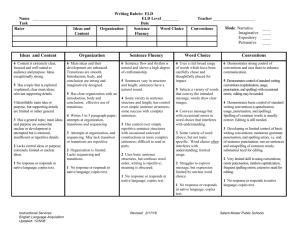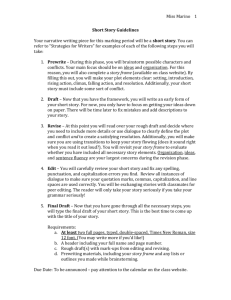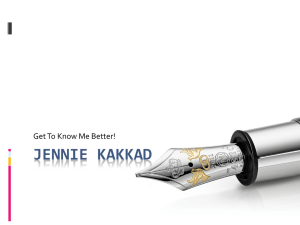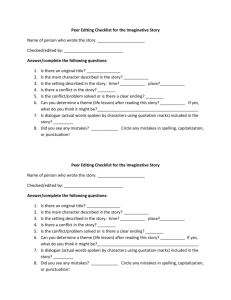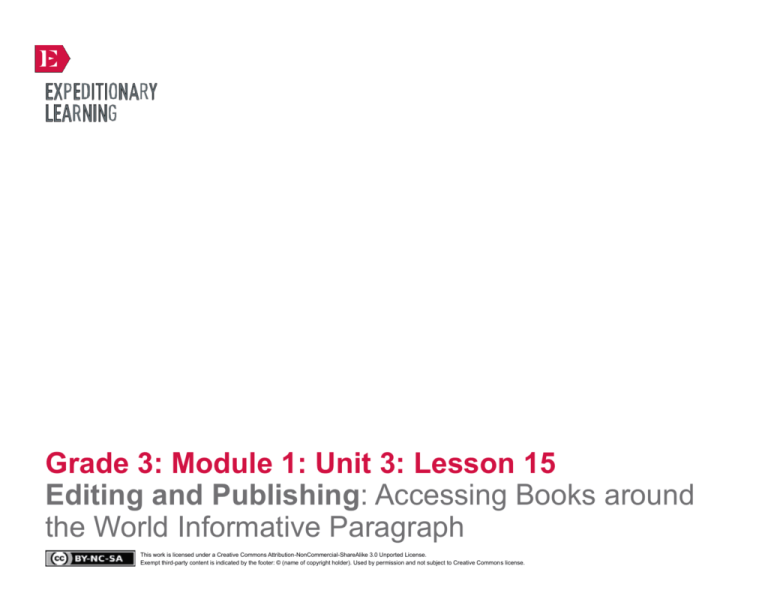
Grade 3: Module 1: Unit 3: Lesson 15
Editing and Publishing: Accessing Books around
the World Informative Paragraph
This work is licensed under a Creative Commons Attribution-NonCommercial-ShareAlike 3.0 Unported License.
Exempt third-party content is indicated by the footer: © (name of copyright holder). Used by permission and not subject to Creative Commons license.
GRADE 3: MODULE 1: UNIT 3: LESSON 15
Editing and Publishing: Accessing Books around
the World Paragraph)
Long-Term Targets Addressed (Based on NYSP12 ELA CCLS)
I can use the writing process to plan, revise, and edit my writing (with support). (W.3.5)
I can use conventions to send a clear message to my reader. (L.3.2)
Supporting Learning Targets
Ongoing Assessment
• I can write a final draft that reflects craftsmanship.
• Final published paragraph
• I can use correct capitalization in my writing.
• I can use correct end punctuation in my writing.
• I can spell grade-appropriate words correctly.
• I can use resources to check and correct my spelling.
Agenda
Teaching Notes
1.
• Ensure that you have completed a Conventions checklist for each student. This is essential for Work
Time Part C.
Opening
A. Engaging the Writer (5 minutes)
2. Work Time
A. Mini Lesson: Editing Conventions (5 minutes)
• Bookmark Publication Tip: Students may write their final published paragraphs on a standard-sized
piece of paper, which can then be reduced in size on a photocopier to match the size of the bookmark
cardstock.
B. Application: Editing Conventions (20 minutes)
C. Mini Lesson: Craftsmanship (5 minutes)
D. Publishing Paragraphs, Part 1 (20 minutes)
3. Closing and Assessment
A. Debrief (5 minutes)
4. Homework
Copyright © 2013 by Expeditionary Learning, New York, NY. All Rights Reserved.
NYS Common Core ELA Curriculum • G3:M1:U3:L15 • June 2013 •
1
GRADE 3: MODULE 1: UNIT 3: LESSON 15
Editing and Publishing: Accessing Books around
the World Paragraph)
Lesson Vocabulary
Materials
correct, grade-appropriate, resources,
reflect, check, handwriting,
craftsmanship, capitalization, ending,
punctuation, publish
• Students’ paragraph drafts with revisions
• Accessing Books around the World Paragraph Conventions Checklist (from Lesson 12; for teacher use)
• Final draft paper
Opening
Meeting Students’ Needs
A. Engaging the Writer (5 minutes)
• Recap the writing journey students have been on with their Accessing Books around the World bookmarks. They have
planned, drafted, and revised their paragraphs. Today is an editing day, which means students correct spelling, punctuation,
and capitalization of their writing.
• Consider providing nonlinguistic
symbols to assist ELLs in making
connections with vocabulary. These
symbols can be used throughout the
year.
• Distinguish editing from revision. Refer to the supporting targets of the lesson, clarifying the words capitalization, spell,
resources, and punctuation.
• Remind students that when they edit their writing for these conventions, their work reflects craftsmanship which is another
word for care and quality in presentation.
• ELLs can enter craftsmanship into
their personal dictionaries or
vocabulary logs.
• Tell students they will rewrite their final paragraphs using their most careful handwriting when they have finished editing.
This is also an element of craftsmanship.
Copyright © 2013 by Expeditionary Learning, New York, NY. All Rights Reserved.
NYS Common Core ELA Curriculum • G3:M1:U3:L15 • June 2013 •
2
GRADE 3: MODULE 1: UNIT 3: LESSON 15
Editing and Publishing: Accessing Books around
the World Paragraph)
Work Time
Meeting Students’ Needs
A. Mini Lesson: Editing Conventions (5 minutes)
• Model for students how to use the Accessing Books around the World Paragraph Conventions Checklist and their
draft writing to edit their spelling, capitalization, and punctuation.
• Consider providing nonlinguistic
symbols on the Conventions
checklist to support students.
• First, model for students about how writers read through their drafts to identify words that are misspelled. Model for
students how they should mark these words and then find the correct spelling for their words from classroom resources: on
word walls, in dictionaries, on vocabulary cards, or in the texts used throughout the module. Sometimes students may need
someone to simply correct the spelling of words that third-graders do not need to know how to spell on their own.
• Students needing additional support
will benefit from a few targeted
areas for editing marked on their
paragraphs.
• Invite students to share the rules for capitalization (i.e., start of sentences and proper nouns). Next, model how to search for
capital letters at the start of sentences and with names of specific people and places. Support students by identifying places
in their writing where they need to add capital letters before they begin editing independently.
• During Work Time, pull small,
targeted needs-based groups of
students as required.
• Discuss end punctuation. Remind students that punctuation marks are important signals that help readers know when to
slow down, stop, or read with expression Students should be on the lookout for places where they need to include a period,
question mark, or exclamation point in their paragraphs. Support students by identifying places in their writing where they
need to add ending punctuation before they begin editing independently.
B. Application: Editing Conventions (20 minutes)
• Students spend 20 minutes of this session editing their writing for correct capitalization, spelling, and punctuation. Remind
students to use their Conventions checklists to identify what they need to work on. Confer with students and offer support
and guidance as needed.
• Refer to a nonlinguistic symbol for
craftsmanship to assist ELLs in
making the connection.
C. Mini Lesson: Craftsmanship (5 minutes)
• Briefly review the word craftsmanship. Remind students that work that shows craftsmanship is neatly and carefully created.
This is important because the reader needs to be able to understand our writing. Show students a final handwritten
paragraph and invite them to Pair-Share what they notice about the craftsmanship of a published paragraph. Connect the
word publish to the writing process vocabulary used throughout the unit. Track students’ ideas about craftsmanship on an
anchor chart titled: When Writers Show Craftsmanship, What Do They Do?
• ELLs may require extended time for
completion of task and use of a
bilingual dictionary.
• Suggested ideas for the chart include:
* Put spaces between their words
* Use their neatest handwriting
Copyright © 2013 by Expeditionary Learning, New York, NY. All Rights Reserved.
NYS Common Core ELA Curriculum • G3:M1:U3:L15 • June 2013 •
3
GRADE 3: MODULE 1: UNIT 3: LESSON 15
Editing and Publishing: Accessing Books around
the World Paragraph)
Work Time (continued)
Meeting Students’ Needs
D. Publishing Paragraphs, Part 1 (20 minutes)
• Students write their final revised and edited paragraphs onto a new sheet of paper, attending to the elements of
craftsmanship generated during the lesson. Confer with students and provide feedback and guidance as needed.
• ELLs may need extended time to
write their hooks.
Note: Students will also have 15 minutes in the next session will to continue publishing their paragraphs.
Closing and Assessment
Meeting Students’ Needs
A. Debrief (5 minutes)
• Invite students to pair share their successes and challenges connected to craftsmanship:
• Post a sentence starter and model to
assist as students participate in
discussion: “I am most proud of
______” and “Writing neatly is a
challenge for me because
______________.”
* “What are you most proud of?”
* “What was challenging for you?”
Meeting Students’ Needs
Homework
• Ideally, students will finish editing their writing at school; however, if students need more time to complete the task, they
may take their writing home to complete.
Note: Photocopy students’ writing before they take it home to ensure a backup copy if needed.
Copyright © 2013 by Expeditionary Learning, New York, NY. All Rights Reserved.
NYS Common Core ELA Curriculum • G3:M1:U3:L15 • June 2013 •
4

